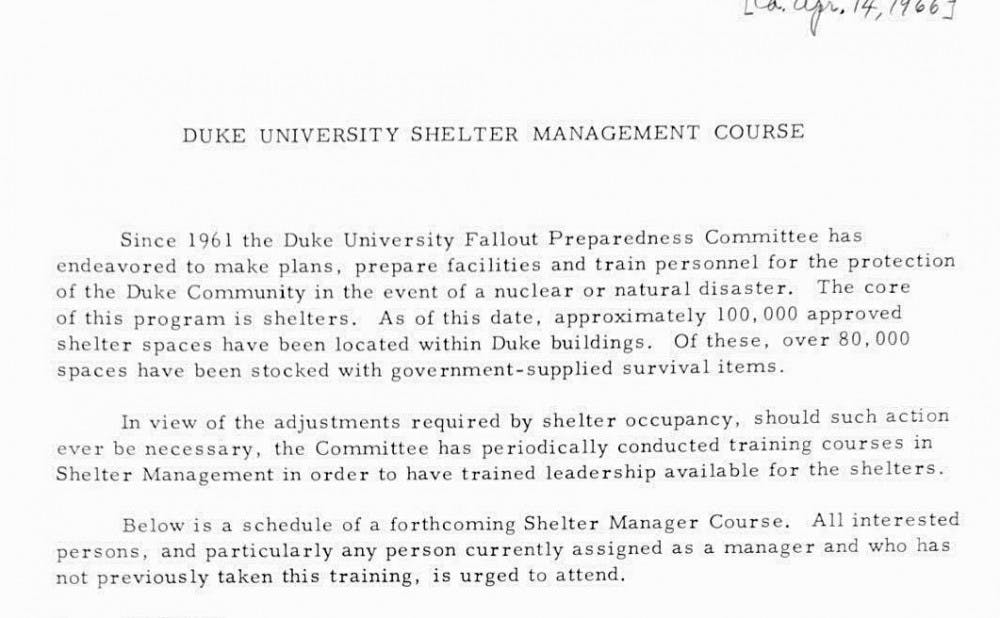At the height of the Berlin Crisis of 1961, a University committee developed plans to house nearly 50,000 Duke and Durham community members in shelters across campus.
The committee, formally called the Fallout Preparedness Committee, was formed in September of 1961 by President Julian Daryl Hart to prepare the University for a possible nuclear attack. The new committee expanded upon plans to use the Duke University Medical Center and other campus locations as fallout shelters. It met over the course of more than five years, publishing its findings in a series of reports from 1961 through 1963.
"The Trustees and the Administration feel a keen sense of responsibility in providing adequate fallout protection and information to the Duke University family," Hart wrote in a letter to Duke students, faculty and staff.
The committee's 33 members reported to the chair, William Anlyan, who was then a professor of surgery in the School of Medicine. Under the committee's leadership were eight sub-committees dedicated to topics such as analyzing life in fallout shelters on campus and studying the engineering and construction needed to improve infrastructure.
The committee's reports included individual shelter assignments by department and dorm, analysis of budgets necessary to supply necessities for up to two weeks and dozens of other plans for protecting the Duke community in the aftermath of a nuclear disaster.
The 1963 report—the most comprehensive analysis produced by the committee—included findings from each subcommittee that reveal the scope of the University's plan, including expansions for campus water and electrical infrastructure.
Planning for disaster
The committee aimed "to make plans, prepare facilities and train personnel for the protection of the Duke Community in the event of a nuclear or natural disaster," according to a 1966 flyer for Duke University Shelter Management Course in the University Archives.
Nuclear disaster planning was based on the worst-case scenario—the use of a nuclear weapon on Greensboro, N.C. The committee's report stated that prevailing winds would send more fallout toward the Durham community than a similar nuclear strike on Raleigh, N.C., despite its proximity.
In order to prepare for such an event, the Fallout Committee also organized community-wide presentations on the dangers of nuclear fallout, plans for fallout protection and housekeeping in shelters.
Other plans included fallout shelter rehearsals for all students, according to a 1962 article in The Chronicle.
Guidelines on fallout protection were distributed to all members of the Duke community. They covered instructions on what to do in the immediate aftermath of a nuclear disaster and information on shelter organization.
A shelter for Durham?
Chief among the committee's responsibilities was a plan to house University community members in on-campus fallout shelters in the event of a nuclear disaster.
By 1966, the committee has identified more than 100,000 approved spaces for fallout shelters in Duke buildings and had supplied more than 80,000 of them with fallout survival supplies, including nonperishable food, fresh water, medical supplies and bedding.
Along with standard medical supplies, each shelter would include a clergy member, a licensed physician and two nurses, according to a letter from Robert Cushman, dean of the Divinity School in 1962.
The thousands of shelters included room for 800 people in the basement of the Chapel and more than 1,000 across two floors of Page Auditorium. These spaces were mostly on West Campus or in the Duke Medical Center.
Students on East Campus were expected to walk to West Campus to seek shelter, according to shelter assignments released by the committee.
The University was prepared to shelter for up to two weeks for 25,000 Duke community members, including undergraduates, graduates, faculty, staff and family members.
"The University has medical supplies and sufficient food to support the entire student body in fallout shelters for at least two weeks," wrote Konrad Knight, the University's chief radiological safety officer, in a committee report.
Despite the scale of these plans, Duke administration felt that the school could plan even more broadly with greater federal financial support.
"One source of frustration [for the administration] is that the University buildings can accommodate approximately 48,000 other (for a total of 73,000 people—or a majority of the City of Durham) members of the Durham community at a reasonable cost per person, yet the community and the local Civil Defense authorities do not have the funds to provide this support," wrote University Provost Robert Taylor Cole in a letter to Benjamin Everett Jordan, U.S. Senator from North Carolina.
Cole also wrote that the Duke plan should serve as a model for other universities around the country to develop a broader network of fallout-ready shelters.
Get The Chronicle straight to your inbox
Signup for our weekly newsletter. Cancel at any time.

